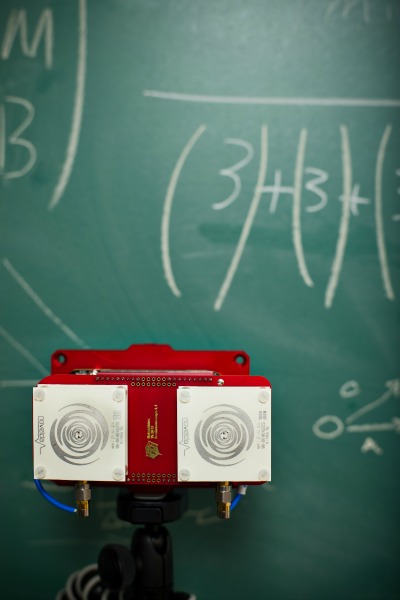June 21, 2016
Photo credit: Luther Caverly
Sensor Expert Envisions a Future of Unobtrusive Monitoring for Health and Well-being
Dr. Sreeraman Rajan, an electronics engineer with expertise in sensors and signal processing, waxes poetic when it comes to imagining a future that makes efficient and meaningful use of the mountain of information gleaned through various types of sensing.

Hired last summer as Carleton’s Canada Research Chair on Sensor Systems, Dr. Rajan is hoping to parlay his industry and government background into a closer examination of the potentiality of signal processing of sensors, particularly in light of the growing demographic of seniors, who may need unobtrusive monitoring in their homes or in hospitals.
While smart sensors have already become an integral part of our lives – from defence applications to patient health monitoring – by studying novel signal processing methodologies for extracting vital signs, for example, Dr. Rajan hopes to address some fundamental questions in signal processing that will spur the development of the next generations of sensor systems that can ultimately be used in several domains.

His passion for finding solutions surely stems from his early school days in India, when he would run to class clutching flowers plucked from his grandfather’s garden, so he could explain their classifications to his fellow students when his biology teacher found the topic too boring.
His far-reaching interests in all things biological and mathematical still continues today as he explores novel solutions in biomedical research as well as electronic warfare through the study of signal processing.
“We can collect a lot of data and intelligence, but is more better or is less better? And how much data is adequate?” asks Dr. Rajan, who is also an associate professor in the Department of Systems and Computer Engineering. “And then, how reliable is it? A smart phone can tell me whether or not I slept well, but is it right or wrong, and who decides? This is not just the domain of engineers,” he adds. “We need doctors too to make the reference. In order to provide the most clinically relevant information, we need a lot of signal processing as well as expertise.”

While Dr. Rajan admits it isn’t easy to make meaningful solutions from big data, he imagines that a methodology for using information more efficiently will result in a more significant solution for elderly patients, for the ill in underprivileged countries, and even for detecting life through rubble in disaster zones.
Under the $500,000 grant that comes with the five-year Canada Research Chair title, Dr. Rajan will look at various kinds of sensors, including ambient environments that are sensitive and responsive to the presence of people without being obtrusive.

“Ambient sensors are now being used,” says Dr. Rajan, “but not in the way I would like to see. I want to take it to a level where information can be monitored without depending on a patient to wear a device or to be compliant. I am asking, ‘Can this be done?’ and the answer seems to be ‘Yes.’”
Radar sensing is another area that interests Dr. Rajan, who suggests even a small change in a niche area could have a big impact: “Sleep apnea, for example. With a radar sensor that monitors you in the comfort of the home while you are sleeping, the quality of your sleep can be determined without any constraints. It would tell me more about your sleep in an unobtrusive, privacy-conserving way. It would provide more meaningful data based on reality.
“I see more of these futuristic things becoming real,” says Dr. Rajan, who also points to the possibilities of connecting a patient in a remote African village with a North American doctor who could perform robotic surgery with fairly simple technology.
Since Dr. Rajan received his bachelor degree in electronics and communications engineering from Bharathiyar University in India in 1987, and his master of science in electrical engineering from Tulane University in New Orleans in 1992, he has devoted decades to researching sensor systems, sensor data processing, sensor data analytics in defence, security and biomedical areas, as well as signal processing for electronic warfare systems and non-invasive medical devices.

He was involved for three years in the regulation of nuclear research and power reactors at the Bhabha Atomic Research Center in Bombay.
After earning a PhD in electrical and computer engineering from the University of New Brunswick, he worked for Defence Research and Development Canada (DRDC) for 10 years before coming to Carleton University. As a DRDC defence scientist, he worked in communication and radar electronic warfare. While he successfully led several military field trials in radio frequency emitter geolocation and field tested high-performance direction finding systems, so much of his work was classified.
“The work you do becomes obscure. I wanted to work in an environment where I could work in electronic warfare and signal processing and non-invasive physiological signal processing for biomedical devices and sensing,” Dr. Rajan explains. “I felt I could do more relevant work in a university setting, including bringing together industry, academia and government to work cooperatively. You need that kind of a larger expertise to solve some problems.”

He also developed a heart murmur detection system while a visiting research associate at Siemens Corporate Research in New Jersey, developed signal processing algorithms for non-invasive medical devices at Biopeak Corporation in Ottawa, and developed channel monitoring, gain equalization solutions for ultra long haul fibre optical communication systems at Ceyba Corporation in Ottawa.
Share: Twitter, Facebook